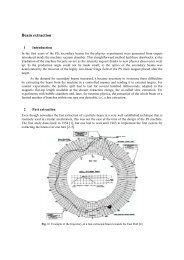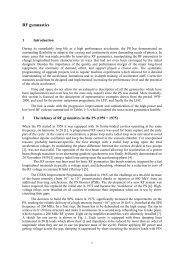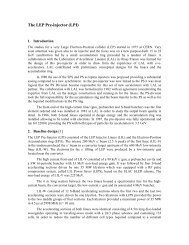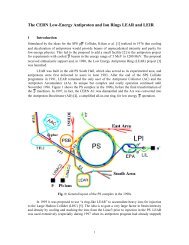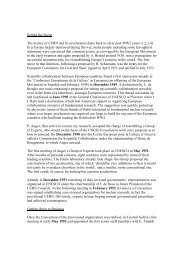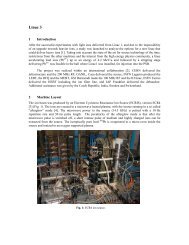Beam extraction - 50th anniversary of the CERN Proton Synchrotron
Beam extraction - 50th anniversary of the CERN Proton Synchrotron
Beam extraction - 50th anniversary of the CERN Proton Synchrotron
You also want an ePaper? Increase the reach of your titles
YUMPU automatically turns print PDFs into web optimized ePapers that Google loves.
Section 54<br />
Section 55<br />
Section 21<br />
Section 20<br />
Extraction line<br />
Flying wires<br />
Sextupole magnets<br />
Kicker magnet<br />
Octupole magnets<br />
Slow bump<br />
Extraction<br />
septum<br />
Section 16<br />
Section 64<br />
Section 71<br />
Fig. 26: Schematic layout <strong>of</strong> <strong>the</strong> PS machine with <strong>the</strong> elements used for <strong>the</strong> experimental study <strong>of</strong> <strong>the</strong><br />
novel multi-turn <strong>extraction</strong> (left). Schematic layout <strong>of</strong> <strong>the</strong> mechanism <strong>of</strong> <strong>the</strong> PS wire scanner (upper<br />
right). The installation <strong>of</strong> <strong>the</strong> scintillators on both sides <strong>of</strong> <strong>the</strong> vacuum pipe is also shown (lower<br />
right).<br />
Under <strong>the</strong>se new conditions it was indeed possible to increase <strong>the</strong> fraction <strong>of</strong> particles inside <strong>the</strong><br />
islands, achieving a value <strong>of</strong> 18% against a previous value <strong>of</strong> about 13%. It is worth while mentioning<br />
that for <strong>the</strong> optimal performance <strong>of</strong> <strong>the</strong> SPS machine, <strong>the</strong> tolerance for <strong>the</strong> fraction <strong>of</strong> particles in each<br />
beamlet is (20±5)%. Therefore, if this needs to hold for <strong>the</strong> central core, <strong>the</strong>n, <strong>the</strong> four beamlets should<br />
satisfy <strong>the</strong> tighter limit (20±1)% as any deviation in beamlets intensity is reflected on <strong>the</strong> core amplified<br />
by a factor <strong>of</strong> four. However, <strong>the</strong> price to pay was <strong>the</strong> presence <strong>of</strong> slightly higher losses during resonance<br />
crossing up to <strong>the</strong> level <strong>of</strong> 2%–3% <strong>of</strong> <strong>the</strong> total beam intensity.<br />
The main parameters <strong>of</strong> <strong>the</strong> single-bunch beams used in <strong>the</strong> experimental campaign are<br />
summarized in Table 1.<br />
Table 1: Parameters <strong>of</strong> <strong>the</strong> single-bunch beams used for <strong>the</strong> experimental tests <strong>of</strong> <strong>the</strong> novel multi-turn<br />
<strong>extraction</strong>. The emittance is <strong>the</strong> normalized, one-sigma value.<br />
Parameter<br />
Intensity<br />
(protons/bunch)<br />
ε* H (σ)<br />
(μm)<br />
ε* V (σ)<br />
(μm)<br />
Δp/p (σ)<br />
10 −3<br />
Low-intensity, pencil beam 5×10 11 2.3 1.3 0.25<br />
Low-intensity, large horizontal emittance 5×10 11 6.2 1.6 0.25<br />
High-intensity beam 6×10 12 9.4 6.4 0.60<br />
22



